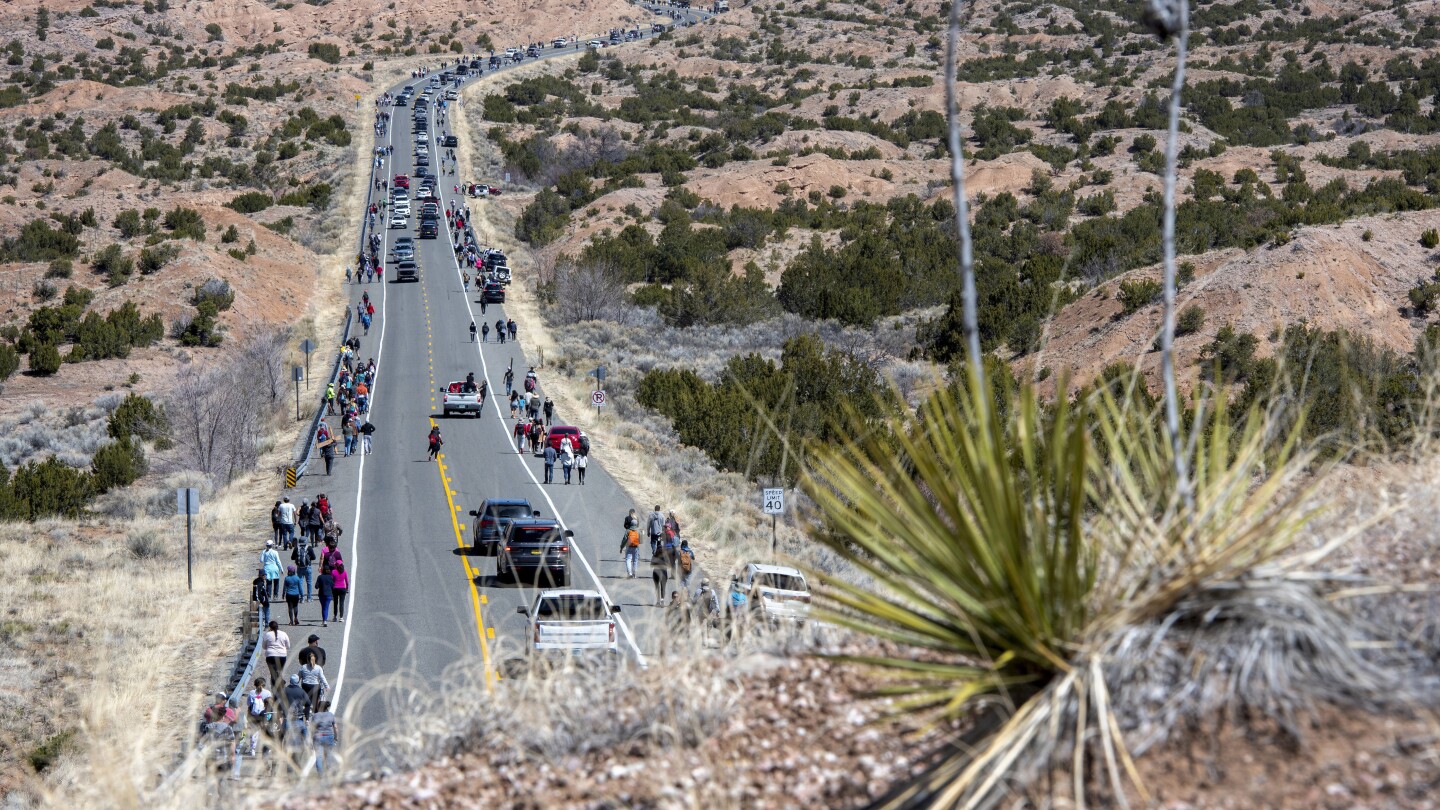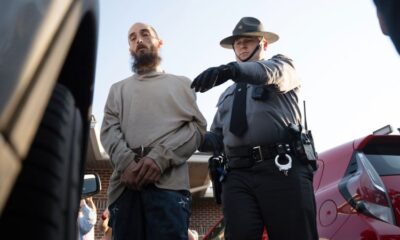Lifestyle
At a little known Rolls-Royce museum in Pennsylvania farm country, volunteers dote over iconic cars

MECHANICSBURG, Pa. (AP) — Mike Fowler had been faintly aware that a museum of Rolls-Royce and Bentley vehicles existed near his boyhood home in the suburbs of Harrisburg, Pennsylvania, but the car enthusiast didn’t expect the experience he got when he started volunteering there.
Fowler had oil on his hands within a half-hour of his first volunteer session at the Rolls-Royce and Bentley Museum. More than a year later, he keeps a list on his phone with notes about cars in the collection to help him get them started properly or disconnect their batteries.
Fowler is part of a group of about 50 volunteers who gather twice a month at the museum to help out, including cleaning, maintaining and driving the fleet of customized iconic vehicles, many designed to be driven by a chauffeur. For many volunteers, it’s an opportunity to experience a life few people can afford.
Tommy Tate opens the hood of a 1946 Rolls-Royce Silver Wraith during an interview at The Rolls-Royce Foundation in Mechanicsburg, Pa., Saturday, April 5, 2025. (AP Photo/Matt Rourke)
Lanny Hake backs up a car at the at The Rolls-Royce Foundation in Mechanicsburg, Pa., Saturday, April 5, 2025. (AP Photo/Matt Rourke)
A 1954 Rolls-Royce Silver Dawn ornament at The Rolls-Royce Foundation in Mechanicsburg, Pa., Saturday, April 5, 2025. (AP Photo/Matt Rourke)
Volunteers gather at The Rolls-Royce Foundation in Mechanicsburg, Pa., Saturday, April 5, 2025. (AP Photo/Matt Rourke)
“You take it out on the road and you are transported to a different time, a different mentality,” said Fowler, a 28-year-old Camp Hill resident.
Newcomers are first paired with a more experienced volunteer for about a year and must pass the museum’s driving school. They start with the most modern vehicles, which have automatic transmissions.
“We’re very protective of the collection. We’re its caretakers, and we take it very seriously. So you can’t just come in off the street and start driving,” said Sarah Holibaugh, the museum’s head librarian and archivist. “But it should be that way.”
Mike Fowler drives a 1946 Rolls-Royce Silver Wraith at The Rolls-Royce Foundation in Mechanicsburg, Pa., Saturday, April 5, 2025. (AP Photo/Matt Rourke)
A museum that’s easy to miss
The 29 antique and collectible Rolls-Royce and Bentley automobiles that date as far back as the late 1920s are the central attraction of the largely overlooked and seldom visited museum, which is easy to miss among the surrounding miles of farm fields and stretch of nondescript industrial buildings just outside Mechanicsburg. The museum, owned by the Rolls-Royce Foundation, includes a showroom, maintenance area and a third room being converted into a library and reading room.
“I often wonder if the homes around here know the foundation exists,” Fowler said. “Or if they always just wonder, ‘Why do we see these vintage Rolls-Royce and Bentleys roaming around from time to time?’”
The museum has its roots in nearby Harrisburg, where Rolls-Royce put an owners’ club in the 1960s, located between large dealerships in New York and Washington. After Hurricane Agnes devasted that location in 1972, a businessman donated the Mechanicsburg property for a new facility. The 6,000-person owners’ club, with members in 26 countries and a headquarters in the same complex, is a separate entity but works closely with the museum.
Though admission is just $5, the museum launched in 2004 gets only about 1,000 visitors a year. It typically draws members of car clubs, groups of seniors and students on school field trips, with visits that have to be scheduled in advance.
Mike Fowler drives a 1946 Rolls-Royce Silver Wraith from the The Rolls-Royce Foundation’s collection in Mechanicsburg, Pa., Saturday, April 5, 2025. (AP Photo/Matt Rourke)
Mike Fowler drives a 1946 Rolls-Royce Silver Wraith at The Rolls-Royce Foundation in Mechanicsburg, Pa., Saturday, April 5, 2025. (AP Photo/Matt Rourke)
Shown is the logo of a 1959 Rolls-Royce Silver Cloud I at The Rolls-Royce Foundation in Mechanicsburg, Pa., Saturday, April 5, 2025. (AP Photo/Matt Rourke)
Volunteers gather at The Rolls-Royce Foundation in Mechanicsburg, Pa., Saturday, April 5, 2025. (AP Photo/Matt Rourke)
Sarah Holibaugh, head librarian and archivist at The Rolls-Royce Foundation speaks with volunteers in Mechanicsburg, Pa., Saturday, April 5, 2025. (AP Photo/Matt Rourke)
Shown are various vehicles in the garage at The Rolls-Royce Foundation in Mechanicsburg, Pa., Saturday, April 5, 2025. (AP Photo/Matt Rourke)
Sarah Holibaugh, left, head librarian and archivist at The Rolls-Royce Foundation applauds Randy Churchill,, center, as he is crowned volunteer of the year by the previous year’s honoree Tommy Tate in Mechanicsburg, Pa., Saturday, April 5, 2025. (AP Photo/Matt Rourke)
Mike Caltrider repairs a model part of the automobilia collection at The Rolls-Royce Foundation in Mechanicsburg, Pa., Saturday, April 5, 2025. (AP Photo/Matt Rourke)
Shown is a 1947 Bentley Mark VI Special at The Rolls-Royce Foundation in Mechanicsburg, Pa., Saturday, April 5, 2025. (AP Photo/Matt Rourke)
Who used to own that car?
It also has rented out its cars for films and similar uses. The museum’s 1961 Rolls-Royce Phantom V was in last year’s Timothée Chalamet biopic about Bob Dylan, “A Complete Unknown,” and a 1959 Silver Cloud I from the collection appeared in Season 4 of the series “The Marvelous Mrs. Maisel.”
Volunteers also help preserve and digitize the museum’s archive of ownership and service records for North America, which span from 1907 until 2004, shortly after Rolls-Royce and Bentley were acquired by BMW and Volkswagen, respectively. Records for cars made for the European market are available through the Rolls-Royce Enthusiasts’ Club in the United Kingdom.
The North American records, which are available for a fee and produce the foundation’s biggest revenue stream, have helped prove cars outside of their collection were once owned by famed director Alfred Hitchcock, actor Zsa Zsa Gabor and hockey great Wayne Gretzky.
Foundation records have also debunked claims about purported prior ownership, including a Rolls-Royce vehicle thought to have been owned by country singer Hank Williams Jr.
“We were able to absolutely prove that it was not owned by him,” recalled volunteer Randy Churchill, a Boiling Springs man now retired from a marketing career. “They just thought they had a million-dollar gold mine on their hands.”
Randy Churchill speaks during an interview at The Rolls-Royce Foundation in Mechanicsburg, Pa., Saturday, April 5, 2025. (AP Photo/Matt Rourke)
Vehicles in the museum’s collection range in value from about $30,000 to about $120,000. A whiskey delivery truck appraised at $320,000 has been donated and will soon be on display.
Many of the cars Rolls-Royce has built are still on the road and used models can be surprisingly cheap. But maintaining an older Rolls, with its customized features and expensive parts, can be pricey, noted volunteer Ron Deguffroy, a retired psychologist from Chambersburg.
“The most expensive Rolls-Royce you will buy,” he said, “is a cheap one.”
Mike Caltrider repairs a model part of the automobilia collection at The Rolls-Royce Foundation in Mechanicsburg, Pa., Saturday, April 5, 2025. (AP Photo/Matt Rourke)
A 1954 Rolls-Royce Silver Dawn ornament at The Rolls-Royce Foundation in Mechanicsburg, Pa., Saturday, April 5, 2025. (AP Photo/Matt Rourke)
Lifestyle
Look inside Maine’s ‘Sistine Chapel’ with 70-year-old frescoes

SOLON, Maine (AP) — From the outside, it looks like any other New England church building: a boxy, white structure with a single steeple surrounded by an old stone wall, set against rolling hills and pine forest.
Inside, though, the South Solon Meeting House has a secret unknown even to some who drive through the tiny Maine town every day. The interior of the building is covered in 70-year-old fresco murals that encourage some in the state’s art community to describe it as “Maine’s Sistine Chapel.”
The murals were painted by artists in the 1950s and, while they have long been appreciated by visitors, the recent creation of a website dedicated to them by students at Colby College in Waterville, Maine, has generated new interest in the paintings.
Véronique Plesch, a Colby professor of art, hopes the building inspires more appreciation of frescoes.
“I fell in love with the place, because I have studies frescoes all my life,” said Plesch, who is a member of the board of the historical society that cares for the meeting house. She added that the paintings should stay in public places and not be in private institutions.
The meeting house was built in 1842 and hosted church services until the 1940s, though there were periods of closure, such as times of war. A decade later, Margaret Day Blake found the building in a state of disuse and the former student at the nearby Skowhegan School of Painting and Sculpture put out a call for young artists to paint frescoes under the school’s supervision in 1951.
The artists were given creative freedom and told there would be no limits to subject matter, but that Biblical scenes would “offer rich and suitable” imagery. The interior was covered in such scenes from 1952 to 1956 and the walls remain adorned with frescoes, including one that references Leonardo da Vinci’s “The Last Supper.”
Another fresco depicts the binding of Isaac, in which a hooded Abraham prepares to sacrifice his son on God’s orders. The Great Flood is depicted as it was by Michelangelo at the Sistine Chapel at the Vatican.
Two of the 13 artists — Sigmund Abeles of New York City and Sidney Hurwitz of Newton, Massachusetts — both in their 90s, are still living. Both spoke fondly about their time at the meeting house.
“We would go out there and paint and then take a lunch break in the cemetery behind the building. It was a very idyllic time,” Hurwitz said. “I very much enjoyed it.”
Today, the meeting house, which is open to the public without locks on its doors, serves as a community gathering and performance space. Many of its old features, including box pews made for smaller people of a different time, are still intact.
Abeles recalled painting the scene of Jacob wrestling with the angel from the Book of Genesis.
“It’s a very, very special place, and it was a unique experience” to work on the frescoes, Abeles said.
On a recent Sunday morning, Plesch gave a lecture at the meeting house before a group of members of the Maine Art Education Association as part of the group’s spring conference. Long ago, attendants of the building might have been preparing for an Easter service, but on this day it was full of teachers fascinated by the frescoes.
Suzanne Goulet, an art teacher at a nearby high school, said she was previously aware of the frescoes and confessed she had peaked into the windows of the old building, adding that it’s great the paintings are still inspiring art lovers decades later.
“The inspiration is that we bring it back to our students,” Goulet said.
Lifestyle
Thousands of pilgrims trek through New Mexico desert to historic adobe church for Good Friday

SANTA FE, N.M. (AP) — A unique Holy Week tradition is drawing thousands of Catholic pilgrims to a small adobe church in the hills of northern New Mexico, in a journey on foot through desert badlands to reach a spiritual wellspring.
For generations, people of the Upper Rio Grande Valley and beyond have walked to reach El Santuario de Chimayó to commemorate Good Friday.
Pilgrims, some walking for days, were on track to arrive Friday amid a forecast of cool temperatures and sprinkles of rain.
Some travelers are lured by an indoor well of dirt believed to have curative powers. Throughout the year, they leave behind crutches, braces and canes in acts of prayer for infirm children and others, and as evidence that miracles happen.
Easter week visitors file through an adobe archway and narrow indoor passages to find a crucified Nuestro Señor de Esquipulas at the main altar. According to local lore, the crucifix was found on the site in the early 1800s, a continent away from its analog at a basilica in the Guatemalan town of Esquipulas.
A spiritual place
Chimayó, known for its artisan weavings and chile crops, rests high above the Rio Grande Valley and opposite the national defense laboratory at Los Alamos that sprang up in the race to develop the first atomic weapon.
The iconic adobe church at Chimayó was cast from local mud at the sunset of Spanish rule in the Americas in the early 1800s, on a site already held sacred by Native Americans.
Set amid narrow streets, curio shops and brooks that flow quickly in spring, El Santuario de Chimayó has been designated as a National Historic Landmark that includes examples of 19th century Hispanic folk art, religious frescoes and saints carved from wood known as bultos.
One votive room is filled with notes of thanks from those who say they had ailments cured.
A separate chapel is dedicated to the Santo Niño de Atocha, a patron saint of children, travelers and those seeking liberation and a fitting figure of devotion for Chimayó pilgrims on the go.
Hundreds of children’s shoes have been left in a prayer room there by the faithful in tribute to the holy child who wears out footwear on miraculous errands. There are even tiny boots tacked to the ceiling.
Pueblo people who inhabited the Chimayó area long before Spanish settlers believed healing spirits could be found in the form of hot springs. Those springs ultimately dried up, leaving behind earth attributed with healing powers.
A way of life
Photographer Miguel Gandert grew up in the Española valley below Chimayó and made the pilgrimage as a boy with his parents.
“Everybody went to Chimayó. You didn’t have to be Catholic,” said Gandert, who was among those who photographed the 1996 pilgrimage through a federal grant. “People just went there because it was a powerful, spiritual place.”
Scenes from that pilgrimage — on display at the New Mexico History Museum in Santa Fe — include children eating snow cones to keep cool, men shouldering large wooden crosses, infants swaddled in blankets, bikers in leather and weary pedestrians resting on highway guardrails to smoke.
A generation later, Good Friday pilgrims still haul crosses on the road to Chimayó, as families leave behind cars, push strollers and allow time for older hikers. Throngs of visitors often wait hours for a turn to file into the Santuario de Chimayó to commemorate the crucifixion.
It’s just one of hundreds of adobe churches anchoring a uniquely New Mexican way of life for their communities. Many are at risk of crumbling into the ground in disrepair as congregations and traditions fade.
A journey on foot
Pilgrims from nearby towns set out for Chimayó in the predawn hours. Some have walked 20 miles (32 kilometers) from Santa Fe, while others traveled for days from Albuquerque and elsewhere.
Vendors sell religious trinkets, coffee and treats. State transportation workers, law enforcement agencies and other volunteers are stationed along the roadway to ensure safety from oncoming traffic, the outdoor elements and exhaustion.
Pilgrims traverse an arid landscape speckled with juniper and piñon trees and cholla cactus that finally give way to lush cottonwood trees and green pastures on the final descent into Chimayó.
The magnitude of the religious pilgrimage has few if any rivals in the U.S. Many participants say their thoughts dwell not only on Jesus Christ but on the suffering of family, friends and neighbors with prayers for relief.
___
Associated Press religion coverage receives support through the AP’s collaboration with The Conversation US, with funding from Lilly Endowment Inc. The AP is solely responsible for this content.
Lifestyle
Ralph Lauren stays closer to home this time with intimate Manhattan gallery show

NEW YORK (AP) — Ralph Lauren, known for staging elaborate runway shows in sumptuous settings like the horsey Hamptons or amid his vintage car collection, took it down a notch for a more intimate show Thursday in a Manhattan gallery space.
As celebrities like Anne Hathaway, Michelle Williams, Julia Louis-Dreyfus, Ariana DeBose and many others watched from the front row, Lauren presented a fall collection dubbed “The Modern Romantics,” heavy on high ruffled necks, classics like buttery leather in everything from aviator jackets to bustiers, and soft cashmere. Evening looks were long and lacy.
Models descended a grand staircase in an airy gallery setting
Lauren’s models first appeared atop a balcony, then each descended a grand staircase to walk the runway. The venue, now the Jack Shainman Gallery, was built in 1898 in the Italian Renaissance Revival style.
For the New York-based crowd, it was much less of a journey than Lauren’s last show in the Hamptons on Long Island, which took some guests four hours from Manhattan in busy traffic.
Lauren himself appeared at the end of the show to wave — from the top of the balcony.
A romantic theme
Lauren said he was celebrating “The Modern Romantics,” an aesthetic he described as “self-assured and unbound by rules.”
Strutting the runway, the models displayed looks that began with a classic Lauren combination of black trousers, a high-necked ruffled white shirt, and an aviator jacket in brown distressed leather.
That was followed by a filmy white midi-dress paired with a thick black leather belt, and tall black leather boots.
A black leather bustier was paired with a long camel wool skirt, and white lacy ruffled shirts popped up in different ensembles — with a long camel coat, or a puffy brown cardigan. There were also white lace neckties. There were velvet jackets, including in a deep shade of purple.
Outfits segued into evening with long, silky or strappy gowns, one in a white crochet theme, another in sumptuous black lace. There was a black halter gown in tiers of ruffles spiraling around the body.
Celebs in attendance
Hathaway, Williams and Watts sat together in the front row, each in a Lauren-style trench or wrap coat. Hathaway, her hair pulled back in a tight ponytail, paired her coat with a pair of tan-colored jeans, embroidered with sequins and strategically shredded.
DeBose wore a smart gray suit that would go perfectly with next month’s Met Gala dress code: “Tailored For You.” Louis-Dreyfus wore a cropped leather jacket in light brown, with white trousers.
Also attending were Sadie Sink, Sarah Catherine Hook, Eiza Gonzalez, Andra Day, Kacey Musgraves and Ella Hunt, among others.
Seen and heard at Lauren’s show
“I thought it was very much his sensibility and what he believes,” Anna Wintour, the influential Vogue editor, said after the show, noting that Lauren’s fashion transcended trends. “He’s a designer that never looks to the left or to the right. He’s just very clear in what he wants to say and what his customer wants, and that’s one of the reasons he’s so unbelievably successful.”
Sarah Catherine Hook, who appeared in the recently concluded third season of “The White Lotus,” said she liked the collection’s ephemeral feel.
“I love anything timeless and I feel like this is the most timeless you could possibly get,” Hook said. “I love the masculine-feminine mix of it and this is my first time getting to wear a necktie, so I’m feeling pretty chic today.”
-

 Conflict Zones2 days ago
Conflict Zones2 days agoAfter two years of war in Sudan, the world can no longer plead ignorance | Conflict
-

 Conflict Zones17 hours ago
Conflict Zones17 hours agoHaiti in ‘free fall’ as violence escalates, rights group warns | Armed Groups News
-

 Education2 days ago
Education2 days agoTrump administration revokes humanitarian parole of Spanish teacher
-

 Europe2 days ago
Europe2 days agoCody Balmer, the suspect in arson at Pennsylvania governor’s home targeted the governor for his views on war in Gaza, warrant says
-

 Africa2 days ago
Africa2 days agoSudan: Rapid Support Forces leader announces rival government
-

 Africa2 days ago
Africa2 days agoWorld Trade Organization says global trade could slide this year due to tariffs
-

 Sports2 days ago
Sports2 days agoNew Orleans Saints win lawsuit over fleur-de-lis trademark filed by ‘direct descendant of the Kings of France’
-

 Sports2 days ago
Sports2 days agoStephen Curry and Jimmy Butler lift the Warriors past the Grizzlies and into the NBA Playoffs




